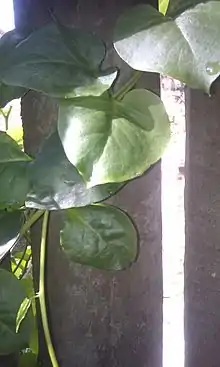Anredera cordifolia
Anredera cordifolia, commonly known as the Madeira-vine[1] or mignonette vine,[2] is a South American species of ornamental succulent vine of the family Basellaceae. The combination of fleshy leaves and thick aerial tubers makes this a very heavy vine. It smothers trees and other vegetation it grows on and can easily break branches and bring down entire trees on its own.[3]
| Anredera cordifolia | |
|---|---|
 | |
| Scientific classification | |
| Kingdom: | Plantae |
| Clade: | Tracheophytes |
| Clade: | Angiosperms |
| Clade: | Eudicots |
| Order: | Caryophyllales |
| Family: | Basellaceae |
| Genus: | Anredera |
| Species: | A. cordifolia |
| Binomial name | |
| Anredera cordifolia | |
| Synonyms | |
|
Boussingaultia basselloides | |
Anredera cordifolia is an evergreen climber that grows from fleshy rhizomes. It has bright green, heart-shaped, fleshy shiny leaves 4–13 cm long. Wart-like tubers are produced on aerial stems and are a key to identifying the plant. It produces masses of small fragrant, cream flowers on dependent racemes, which may be up to 30 cm (12 in) in length. The plant spreads via the tubers, which detach very easily.[3]
Anredera cordifolia can reproduce through the proliferation of tubers and also from rhizome fragments that may be broken off. Although this species has both male and female flowers they rarely reproduce sexually and produce seed. This species often spreads through its own vegetative growth, but can easily be transported by human activities. If fragments end up in waterways, they are easily transported to new locations in this manner.[3]
It has been introduced to Africa, Australasia-Pacific region, Europe, and North America; it is considered an invasive species in many tropical and sub-tropical localities.[3] It is listed on the New Zealand National Pest Plant Accord which limits its cultivation and sale. The Australian Weeds Committee published a Draft Madeira Vine Strategy in August 2012 [4] which is aimed at preventing the spread and reducing the impacts of this vine throughout Australia.[5]


Control
Madeira vine can climb 40 m into the tree canopy, smothering and collapsing mature trees.[6] Mature vines are controlled using the "scrape and paint" method, where the bark is scraped to expose the cambium layer and painted with herbicide. Follow-up three times a year or more is required. Controlling Madeira vine requires exhaustion of the tuber bank. Foliar spraying of glyphosate 360g/L at 1% concentration can manage prostrate growth and newly emerged vines.[6]
References
- "BSBI List 2007". Botanical Society of Britain and Ireland. Archived from the original (xls) on 2015-01-25. Retrieved 2014-10-17.
- Bailey, L.H., Bailey, E.Z., and the staff of the Liberty Hyde Bailey Hortorium. 1976. Hortus third: A concise dictionary of plants cultivated in the United States and Canada. Macmillan, New York.
- Wolff, Mark A. (1999). Winning the war of Weeds: The Essential Gardener's Guide to Weed Identification and Control. Kenthurst, NSW: Kangaroo Press. p. 53. ISBN 0-86417-993-6.
- "Consultation draft – National Madeira Vine Strategic Plan August 2012" (PDF). Commonwealth of Australia and the Australian Weeds Committee. Archived from the original (PDF) on 17 May 2014. Retrieved 19 November 2012.
- "Weed Identification - Australia - Madeira Vine". Weeds Australia. Archived from the original on 19 January 2013. Retrieved 29 November 2012.
- "Weed Management Guide: Madeira Vine" (PDF). Australian Government. Archived from the original (PDF) on 2016-03-26. Retrieved 2015-01-27.
Further reading
- Pink, A. (2004). Gardening for the Million. Project Gutenberg Literary Archive Foundation.
- Invasive Species Specialist Group (ISSG). Anredera cordifolia
- "Weeds - Madeira Vine". Brisbane Rainforest Action & Information Network. Archived from the original on 23 August 2006. Retrieved 19 November 2012.
External links
- Anredera cordifolia Plants For A Future database
- Anredera cordifolia (Ten.) Steenis Medicinal Plant Images Database (School of Chinese Medicine, Hong Kong Baptist University) (in Chinese) (in English)